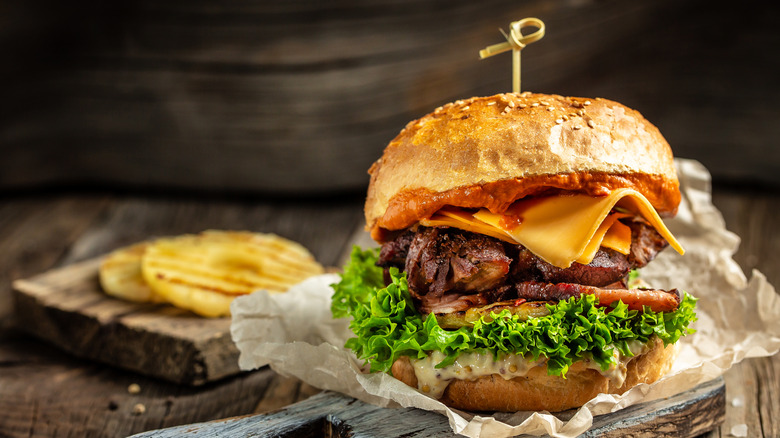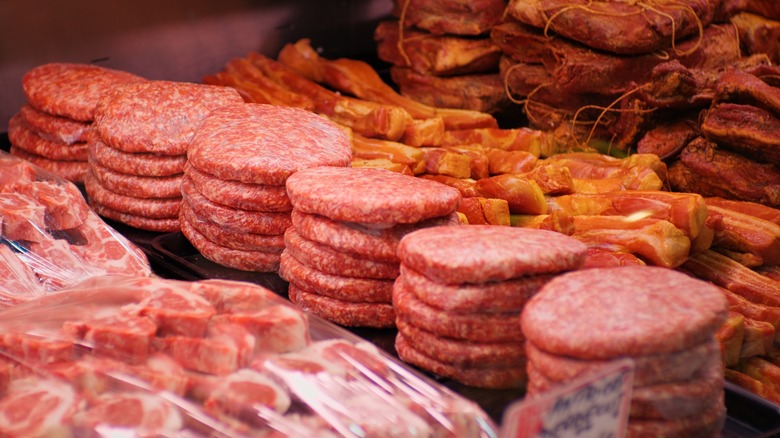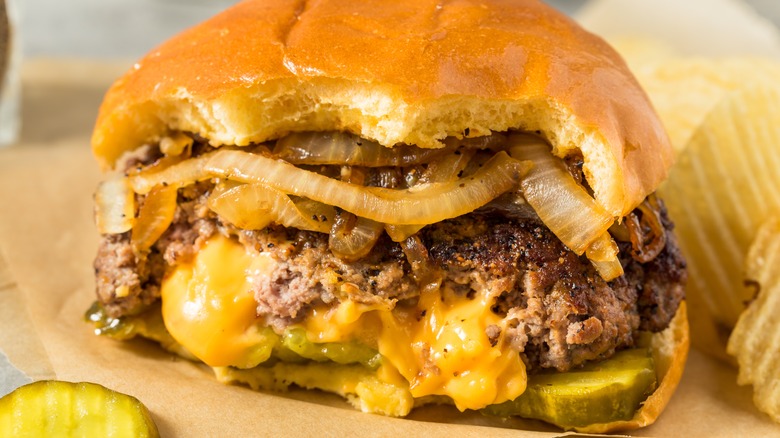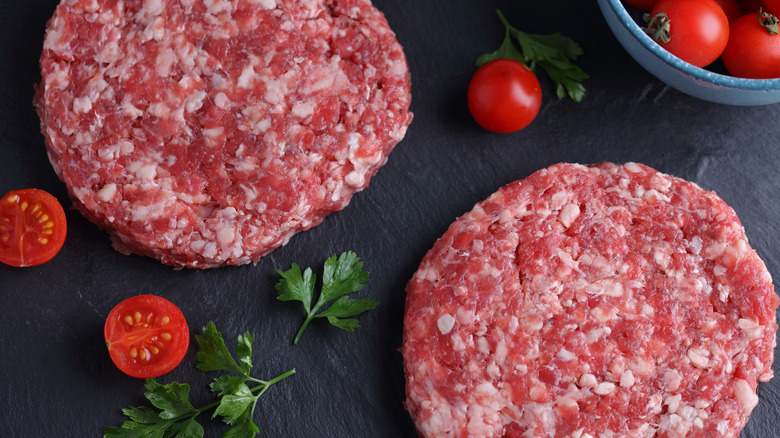Custom Burger Blends That Will Dominate Grilling Season
Chefs may disagree on the best cooking method — grill, stovetop, smashed — and the best toppings — American cheese, special sauce, runny egg — but they all agree that burgers should be juicy, which means we need to accept a certain amount of fat. While traditional American burgers were made with chuck, a primal cut from the inner shoulder of the cow, chefs recognize that blending cuts enables cooks to layer different flavor profiles, customizing the perfect burger for you.
Similar to making meatloaf, which traditionally combines beef, veal, and pork, combining two or more cuts allows you to enjoy the grassy, nutty flavor from a lean cut — like sirloin that would produce a dry, grainy burger on its own — by adding well-marbled meat like brisket to keep the burger moist and together.
Beef is available in varying percentages of leanness. However, burger experts agree that hamburger meat should be at least 80/20 for most recipes: 80% lean protein and 20% fat. Since some fat is lost during cooking, this ratio delivers a juicy, not greasy, burger when cooked just under medium-rare. If you like a black-and-blue burger with the meat still mooing, a leaner 90/10 mix is sufficient. And if well-done is your preference, choose fattier blends like 60/40.
We've compiled a few of our favorite burger blends that you can find at your local butcher or make yourself using a meat grinder with a medium blade or a grinding attachment for a stand mixer.
The perfect flavor-to-fat blend
Take a page from New York City institution Pat LaFrieda Meat Purveyors, which creates over 100 burger blends for restaurants and hotels. LaFrieda has combined chuck, brisket, and short rib for over a century to make its original burger blend, balancing flavor and juiciness. On their own, each cut benefits from slow-cooked braises to break down the muscle and fat, leaving the meat — after hours — fork tender. But when ground together, their marbling leaves a juicy burger at every level of doneness.
Chuck, popular for pot roast, has a rich, beefy flavor and is usually the primary cut in burger blends, roughly 70% of total weight. Chuck's leanness is balanced with less expensive, fattier cuts — brisket and short ribs — to add moisture to the blend. Brisket has intermuscular fat, which is slowly rendered, keeping the burger juicy, even when cooked well-done. The fattest of the blend, short rib, has an intensely beefy, grassy flavor with a taste and texture akin to tender ribeye steaks.
This blend is the perfect blank canvas whether you keep it simple or mile-high with toppings. Sea salt and freshly cracked black pepper are all that's needed to season the patties before grilling. Grill the burgers over high heat to develop a crust, and serve them on toasted potato rolls.
Smoky burger blends
Burger blends are not limited to raw ground beef. Combining a lean cut with fattier cured meat like pastrami or bacon adds depth and guarantees a flavorful burger. Referred to as the Fat Kid Blend at The Meat Hook in Williamsburg, New York, head butcher Tom Mylan combines 70% lean ground beef, like chuck or round, with 30% bacon trimmings to keep the burgers juicy.
Mylan suggests grinding lightly smoked bacon to add sweetness and umami to the patty without dominating the flavor. Still, you can play with other cured meat using guanciale, speck, or applewood smoked bacon.
If you want to take the burger a step further, The Meat Hook adds shredded sharp cheddar cheese as well as crushed sour cream and onion potato chips into its Fat Kid Blend, calling it the "World of Warcraft edition." The flavor profile resembles a cowboy burger or a smoky version of the Juicy Lucy cheeseburger, an American cheese-stuffed patty that oozes cheesy goodness on the first molten bite.
Since the cheese, chips, and bacon trimmings are salty ingredients, cut back on the seasoning until you taste the burger, especially if you add salty toppings. Play around with the type of cheese, adding Pepper Jack for heat or blue cheese for tang. Since the bacon in the patty is meant to provide a subtle smokiness, we wouldn't reject a few slabs of thick-cut bacon on top, too.
Intensely flavored dry-aged burgers
Just because you're grilling in a t-shirt doesn't mean you can't splurge occasionally on a 'fancy' burger. Dry-aged blends will cost you more but have the greatest concentration of meatiness. They impart an earthy, umami flavor similar to parmesan cheese and anchovies. If you're a purest and true beef lover, dry-aged blends require nothing but a bun (maybe buttery brioche).
Quality marbled cuts like tenderloin, sirloin, and rib roast are dry-aged from a week to months, intensifying the beef's flavor and tenderness the longer it ages. Since butchers need to dedicate time and space to the process, dry-aged beef is more expensive than other blends, retailing for over $30 for 1.5 pounds, compared to more traditional burger blends, which retail for about $25 in upscale markets.
Dry-aged beef doesn't need a lot of seasoning. A sprinkle of sea salt and freshly ground black pepper complement its beefiness without masking its natural flavors. Nutty and earthy, dry-aged beef has a rich scent that's best appreciated rare to medium-rare.




